Centauri Dreams
Imagining and Planning Interstellar Exploration
While He’s Away…
Although I’m taking a break from posting, a recent note from Marc Millis suggests something productive that can happen while I’m gone. The founding architect of the Tau Zero Foundation and former head of NASA’s Breakthrough Propulsion Physics project, Marc deals with the issues he asks about below on a daily basis, and so do I. But compiling accurate, non-conflicting information about them can be tricky, which is why we could use your help. Read on.
by Marc Millis
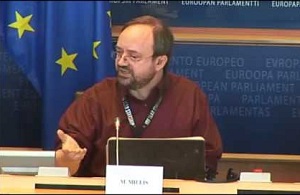
While Paul is away, I have a request for you. We have a number of questions for which we need some help to find reliable answers. For all of you who have been wanting to help, here now is a chance.
When answering these questions, we need to know where you got the information. Please cite the document where you found the information. We are looking for reliable information, so avoid articles that cite values to advocate a particular solution. We have found that some papers skew estimates for such things so that it will support their other assertions (yes, it does happen). Instead, we want information that is without bias. It is even better if that information includes uncertainty ranges to help convey how much the values might vary, and why.
1) What is the minimal sustainable population size for planning world ships?
2) What are the minimum requirements to keep each person alive (volume, biological throughputs [water, food/waste, air], energy)?
3) What is the maximum demonstrated rocket specific impulse (empirical, not theoretical)?
4) What is the minimum energy required to send a detectable signal back to Earth from 4.5 light-years distance?
5) What is the maximum demonstrated duration for reliable operation of contemporary spacecraft hardware?
6) What are the estimates for the maximum duration for reliable operation of space hardware? In other words, what is best warranty period we can anticipate for a deep space probe?
7) What is the best demonstrated pointing accuracy for beamed energy (lasers, microwaves)?
8) Using our own Earth as an example of an extraterrestrial world, how close would our SETI – type detectors need to be in order to detect signals coming from our current emission levels from Earth?
We are looking for the information in this format:
• Value, +/- uncertainty.
• Academic style citation for the document where you got that value (No URLs!).
Example:
• Experimentally measured specific impulse: 17,200 +/- 10% sec
• Byers, D. C. (1969) An Experimental Investigation of a High Voltage Electron Bombardment Ion Thruster, Journal of the Electrochemical Society, Vol. 116, No.1, pp. 9-17.
Post your answers in the comments. Paul tells me he is moderating these daily.

Summer Break for Centauri Dreams
The charged air of mid-July in the northern hemisphere creates states of mind that can be both nostalgic and surreal. Ray Bradbury always knew how to catch these. Listen:

Somewhere, a book said once, all the talk ever talked, all the songs ever sung, still lived, had vibrated way out in space and if you could travel to Far Centauri you could hear George Washington talking in his sleep or Caesar surprised at the knife in his back. So much for sounds. What about light then? All things, once seen, they didn’t just die, that couldn’t be. It must be then that somewhere, searching the world, perhaps in the dripping multiboxed honeycombs where light was an amber sap stored by pollen-fired bees, or in the thirty thousand lenses of the noon dragonfly’s gemmed skull you might find all the colors and sights of the world in any one year. Or pour one single drop of this dandelion wine beneath a microscope and perhaps the entire world of July Fourth would firework out in Vesuvius showers…
I love that ‘thirty thousand lenses of the noon dragonfly’s gemmed skull’ — it takes me instantly to the dragonfly I saw hovering over plants in my backyard this weekend, with a background vista of trees so full that they cut off all sight of other houses as they rose on the hill, so that the deck out back seemed enclosed by forest. The evening air hummed. A year ago a similar mood was on me when I wrote about Bradbury’s Green Town, Illinois, the fictionalized town of his birth and the inspiration for Dandelion Wine. Once again the mood signals it’s time for a summer break.
Centauri Dreams will be back on Thursday the 25th. I wish I could tell you I was headed out for exotic territories, but in fact a number of commitments — some of them space-related but most not — will occupy me, and the break will give me a chance to get to things I’ve been putting off for too long, including work on some longer-form writing projects. See you soon, then, and I hope you find time for a break of your own. Even when travel isn’t possible, long green walks through the imagination still are.

A Blue Planet Nothing Like Our Own
Rayleigh scattering is what happens when light is scattered by particles considerably smaller than the light’s wavelength. Although it can happen in solids and liquids, it’s most obvious when it occurs in our sky, causing its blue color. We’re seeing the short blue wavelengths of sunlight scattered by oxygen and nitrogen molecules in the atmosphere, while red wavelengths are absorbed more strongly, hence less scattering. When you leave the atmosphere and go into space, the Earth appears blue because the oceans absorb red and green wavelengths more than blue ones, and thus we can see the reflected blue color of our sky.
But colors from within the atmosphere or beyond it depend on local conditions. The reddish sky shown by the Viking landers in 1977 was the result of iron-rich dust thrown up by the dust storms that are endemic to the planet. We can assume that the color of other planets as seen from space — think Jupiter or Venus — is the result of particles within their atmospheres. What we can’t assume is that any planet that looks blue from a distance is going to be a clement world like the Earth. That case is made emphatically by the much studied ‘hot Jupiter’ HD 189733b, a transiting planet that has become a laboratory for the study of exoplanet atmospheres.
We’re dealing with an exotic world, one that orbits its star at just one-thirtieth of the Sun/Earth distance, with an atmosphere reaching temperatures well above 1000 degrees Celsius and the subject of frequent battering by stellar flares. Radiation from the parent star is thought to be 20 times more powerful than that from our Sun, with an X-ray dose 3 million times higher than Earth receives. Because it is a transiting world, HD 189733b’s atmosphere can be studied as it leaves its signature on the primary star’s light during passage in front of and then behind the star.
The new work, led by Frédéric Pont (University of Exeter) now tells us that this savage world some 63 light years away would appear, if actually seen by human eyes, a deep azure blue. The measurements were made with the Hubble Space Telescope’s Imaging Spectrograph (STIS), which the team used to monitor how the planet’s light changed during its orbit. Tom Evans (Oxford University) is first author of the paper on this work:
“We saw the brightness of the whole system drop in the blue part of the spectrum when the planet passed behind its star. From this, we can gather that the planet is blue, because the signal remained constant at the other colours we measured.”
The study proceeded by examining the secondary eclipse, when the planet passed behind the star. Here’s a bit on the methodology from the paper:
… we measured the re?ection signal by monitoring the change in brightness of the star-planet system that occurred during secondary eclipse. Unlike the primary transit, which allows us to probe the daynight terminator region of the atmosphere, the secondary eclipse signal is directly related to the brightness of the dayside hemisphere. Although secondary eclipses have been measured previously for HD 189733b at infrared wavelengths…, our new observation constitutes the ?rst measured for HD 189733b at short wavelengths, where thermal emission from the planet is negligible. Any detected light is therefore entirely due to scattering by the atmosphere.
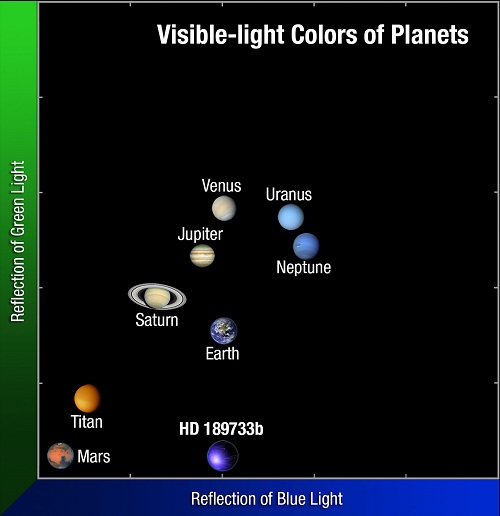
Image: This plot compares the colours of Solar System planets to the colour of the hot Jupiter HD 189733b. With the exception of Mars, the colours are primarily determined by the chemistry of the planets’ atmospheres. Earth’s blue atmosphere plus the blue tint of the oceans dominate our world’s hue. HD 189733b’s deep blue colour is produced by silicate droplets, which scatter blue light in the scorching atmosphere. Credit: NASA, ESA, and A. Feild (STScI/AURA).
The paper calls the color “…a deep, dark blue, quite distinct from the atmosphere colors seen in our solar system.” The blue may well be the result of silicate particles in the atmosphere, which scatter blue light. It’s also consistent with Pont and team’s earlier work on HD 189733b, which revealed the presence of high haze in the atmosphere and suggested red ‘sunset’ colors as the hue of HD 189733b’s sky. Sodium has previously been identified in the atmosphere and, because sodium absorbs red light and dust scatters red, this is an atmosphere that, according to this ESO news release, will redden light shining through it but turn reflected light blue.
As conducted by the Space Telescope Imaging Spectrograph, secondary eclipse observations are obviously a powerful tool. And in this case, HD 189733b once again proves a reliable touchstone on what can be accomplished to analyze the atmospheres of planets we cannot actually image. The paper is Evans et al., “The Deep Blue Color of HD189733b: Albedo Measurements with Hubble Space Telescope/Space Telescope Imaging Spectrograph at Visible Wavelengths,” Astrophysical Journal Letters Vol. 772, No. 2 (2013), L16 (abstract / preprint).

Perspectives on Pluto and Charon
We’re just past the 35th anniversary of the discovery of Pluto’s moon Charon. Or more precisely, we just passed the July 7 date when the announcement of that discovery, which had actually happened in June of 1978, was made. That turned my thoughts back to Larry Niven’s story “Wait It Out,” which tells the tale of two astronauts who are stranded on Pluto’s surface. Removing his helmet to die quickly, the narrator discovers that he lives on in a strange semi-stasis, his brain now a superconductor. First published in 1968 (in All the Myriad Ways), the story contains no Charon, but the scene lingers with me. I’ll quote just a patch of it, though I’ve quoted it before:
A superconductor is what I am. Sunlight raises the temperature too high, switching me off like a damned machine at every dawn. But at night my nervous system becomes a superconductor. Currents flow; thoughts flow; sensations flow. Sluggishly. The one hundred and fifty-three hours of Pluto’s rotation flash by in what feels like fifteen minutes. At that rate I can wait it out.
All of that, coupled with the Charon anniversary, had me thinking about what Pluto’s surface would look like with the moon included. A couple of things come to mind here. Pluto’s axial tilt (obliquity) is 124 degrees, which means that Pluto’s rotational axis is nearly in the plane of its orbit. Charon orbits the dwarf planet in its equatorial plane. Recall too that the length of Pluto’s day is the same as the orbital period of Charon. The result: Charon always presents the same face toward Pluto and vice versa.
That may seem similar to our own Moon, but because Charon orbits over Pluto’s equator, it does not appear to move relative to the horizon. This Southwest Research Institute page on the Phases of Charon, written by Marc Buie, gives further background, but the point is that because Charon orbits Pluto in the same way that communications satellites orbit the Earth, there is never a moonrise from Pluto’s surface. Moreover, the moon is invisible over half the planet.
We wind up with a moon that undergoes regular phases. If the Sun were directly over Pluto’s equator at the start of Plutonian spring, then Charon at its ‘new moon’ phase would move directly in front of the Sun, to produce an eclipse. As it moves through the rest of its 6.4 day orbit, it would progress through a series of phases. The diagram below tells the story:

Image: The Sun crossed the equator in 1988 during the middle of a 6 year season of eclipses that would have been spectacular to watch. This marked the start of spring in the northern hemisphere and the full moon was really full. Credit: SwRI/Marc W. Buie.
But take a look at the start of summer in the Northern hemisphere (this will next happen in 2030). Here the Sun passes over 56 degrees north latitude, roughly where Scotland is on Earth:

And as Buie goes on to explain:
Another longer term cycle also affects the phases and that is Pluto’s orbit around the sun. Since Pluto’s rotation axis is tipped on its side, it has very pronounced seasons. Unlike our Moon, Charon also undergoes the same exact seasons. The only time you’d see a completely full moon would be at the start of spring or fall. At the start of summer or winter, just over half the surface would be illuminated at its fullest, either the north or south polar regions depending on the season.
Charon orbits some 19,000 kilometers away from Pluto. From its surface, Pluto is gigantic in the sky, more than 14 times as wide and with 200 times the area of our Moon in the sky, as Alan Stern notes in his latest PI’s Perspective for the New Horizons mission. We can thank James Christy and Robert Harrington (U.S. Naval Observatory) for the discovery of the largest moon relative to its planet in the Solar System. And we can thank New Horizons for the image below, showing Pluto and Charon as seen from the spacecraft. New Horizons was 550 million miles from Pluto, further than the distance between the Earth and Jupiter, when the photo was taken on July 1, giving us a bit of a gut-check on the distances just to our own outer system.
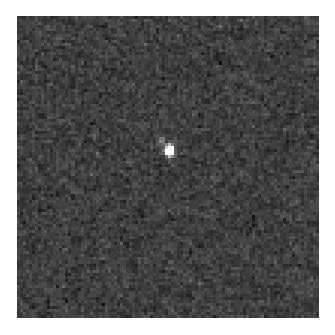
Two years from now, New Horizons will pass just over 12,000 kilometers above Pluto’s surface, where the LORRI imager will be able to spot features about the size of a football field. This is going to be a fascinating system to untangle. Charon’s interior is thought to be a combination of rock and water ice at about 50/50 proportions, while Pluto is far more rocky. The discovery of the largest moon began the study of this system as a double planet, one that is doubtless the result of a collision somewhat similar to what occurred in Earth’s early history to form our Moon. We can only imagine how much more we’ll learn as New Horizons closes the distance to its target.
Image: New Horizons LOng Range Reconnaissance Imager (LORRI) composite image showing the detection of Pluto’s largest moon, Charon, cleanly separated from Pluto itself. The frame is an average of six different LORRI images, each taken with an exposure time of 0.1 second. No other Pluto system objects are seen in the image. Credit: NASA/Johns Hopkins University Applied Physics Laboratory/Southwest Research Institute.

Prophecy, Prediction and Starflight
I’m looking forward to the upcoming Starship Congress hosted by Icarus Interstellar, which will take place in Dallas from August 15th to the 18th at the Hilton Anatole. With an audience of physicists, engineers and researchers of all kinds, this is a chance to catch up with old friends and firm up relationships that have in some cases been pursued solely through email. 2013 may be remembered as the year of the conference in interstellar terms, since we had the Tennessee Valley Interstellar Workshop in February, Starship Century in May, Starship Congress coming up in August, then the 100 Year Starship Symposium in Houston from September 19th to the 22nd.
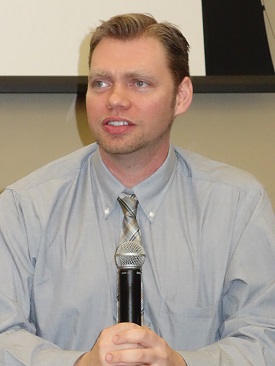
This doesn’t include smaller events like the British Interplanetary Society’s excellent Philosophy of the Starship gathering in late May, and if you’re in range of BIS headquarters in London, it’s worth checking out what’s coming up on their always active schedule. But thoughts of indefatigable activity on the interstellar front always bring me around to Richard Obousy, president of Icarus Interstellar, who appears in a short piece titled Incredible Technology: How to Make Interstellar Spaceflight a Reality, along with Tau Zero Founder Marc Millis. Obousy is, in the best sense, an interstellar optimist.
Image: Richard Obousy, a tireless interstellar advocate now preparing for Starship Congress.
It was in Huntsville for the Tennessee Valley event that I heard Obousy use a phrase he repeated for Space.com’s Mike Wall: “I think a lot of people tend to overestimate what we can accomplish in the short term, in the next five to 10 years. But they also vastly underestimate what we can accomplish in the long term, decades or a century from now.” And that’s right on the money, because when we look ahead just a few years, we often see trends we think will accelerate, but over the long-term it’s often the factors we hadn’t yet considered that make all the difference.
I catch the same optimism in Marc Millis, who as former head of NASA’s Breakthrough Propulsion Physics project knows what it is like to be cut off at the knees by funding problems. Millis thinks the discovery of an Earth-like planet around another star will be a motivator for public engagement with space, resulting in the kind of interest that could spur demand for new exoplanet observatories and, we can hope, funding to support progress in propulsion. Advances in computer technology and the growth of commercial spaceflight, particularly through asteroid mining ventures that will extract resources and return them to Earth, should also help.
Obousy’s observation about underestimating what can happen over the long haul gibes with what David Deutsch argues in The Beginning of Infinity (Viking, 2011). Deutsch distinguishes between ‘prophecy’ and ‘prediction’ when talking about the future, prophecy being the discussion of things that are simply not knowable, whereas prediction involves conclusions that are based on good explanations. When we try to know the unknowable, we create a bias toward pessimism because we cannot know the shape or reach of future knowledge.
The growth of knowledge cannot change that fact. On the contrary, it contributes strongly to it: the ability of scientific theories to predict the future depends on the reach of their explanations, but no explanation has enough reach to predict the content of its own successors – or their effects, or those of other ideas that have not yet been thought of. Just as no one in 1900 could have foreseen the consequences of innovations made during the twentieth century – including whole new fields such as nuclear physics, computer science and biotechnology – so our own future will be shaped by knowledge that we do not yet have. We cannot even predict most of the problems that we shall encounter, or most of the opportunities to solve them, let alone the solutions and attempted solutions and how they will affect events. People in 1900 did not consider the Internet or nuclear power unlikely: they did not conceive of them at all.
Thus it may well be that the solutions we find in 2100 to problems that plague us today will come from directions we have yet to imagine. And I think the Icarus organizers are doing the smart thing by arranging their Starship Congress around time tracks: What can be done in the short-term to accelerate the progress of deep space research? What will be needed 20 to 50 years from now to achieve interstellar goals? And what can we say about longer timescales?
The interface between prediction and prophecy is a challenging place, demanding shrewd analysis and a mind open to possibility. Understanding how short-term prediction can turn into long-term prophecy reminds us of how easy it is to make blanket statements that are invalidated as new knowledge becomes available. Think of Albert Michelson’s address at the University of Chicago in 1894, when he argued that “The more important fundamental laws and facts of physical science have all been discovered, and these are now so firmly established that the possibility of their ever being supplanted in consequence of new discoveries is exceedingly remote… Our future discoveries must be looked for in the sixth place of decimals.”
Thus the view from 1894, with quantum theory and relativity looming in the near future. Deutsch would say that the physics of that year was not able to predict the content of its successors, that in fact it was not capable even of imagining the kind of changes quantum theory and relativity would bring. Comments like Michelson’s should keep us humble as we look ahead.
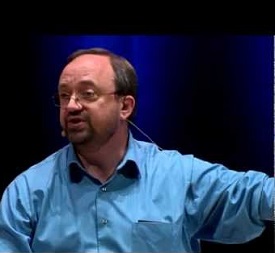
Millis makes much the same point in Mike Wall’s article. He’s been describing the kind of technologies under investigation for advanced propulsion, which include nuclear fusion, solar and beamed-energy sails, antimatter engines and interstellar ramjets. But as he tells Wall, none of these alternatives other than solar sails are even close to being flight-ready. Even the sails we’ve launched are experimental and far smaller than what would be needed for interstellar flight, nor have we any experience in accelerating actual sails in space through beamed energy.
But we want to move forward, and Millis thus advocates “a reasonable portfolio, a small amount spread over everything from the seemingly simple solar sails to the seemingly impossible faster-than-light [engines], and the things in between.” The goal should be to move forward through a series of achievable milestones to build momentum and attract funding. Or as Lao Tzu once put it, “You accomplish the great task by a series of small steps.”
Image: Interstellar researcher and Tau Zero founder Marc Millis.
We don’t know which propulsion option will be the one to take us to the stars, but as Deutsch would remind us, we don’t even know whether the one that actually succeeds is on our current list, because we may not have conceived of it yet. Something the philosopher Karl Popper once said sticks with me. This is from his The Myth of the Framework (Routledge, 1996):
The possibilities that lie in the future are infinite. When I say ‘It is our duty to remain optimists,’ this includes not only the openness of the future but also that which all of us contribute to it by everything we do: we are all responsible for what the future holds in store. Thus it is our duty, not to prophesy evil but, rather, to fight for a better world.

‘A Terrible Beauty’ Among the Stars
Martin Rees’ ideas on how humans will adapt to starflight, discussed here yesterday, offer plenty of ground for speculation and good science fiction. After all, the path ahead forks in many directions, one of them being the continuing development of artificial intelligence to the point where ‘artilects’ rather than humans become the logical crew for star missions. If decades or even centuries are needed to cross to another system, then this gets around the problem of keeping people sane and cooperating across what might be generations of voyaging.
Another fork is biological, with humans being gradually engineered to make them more adaptable to environments they’ll find at their destination. Here we can imagine crews sent out in some kind of deep hibernation, their biology tweaked to allow a ready transition to the new planet. Or perhaps cyborg solutions suggest themselves, with humans augmented by digital technologies to deal with problems and interface directly with critical shipboard computer systems.

I always think of Freeman Dyson when speculating about these things because back in 1985, he lectured in Aberdeen on a one kilogram deep space probe that would be as much biological as mechanical, a genetically engineered symbiosis of animal, plant and electronics. Dyson saw the animal component as providing sensors and nerves and muscles for basic operations and navigation, while electronics dealt with communications and data return. The plant component offered a closed-cycle biochemistry fed by sunlight. Artificial intelligence would integrate all operations in a probe he described as ‘agile as a hummingbird, with a brain weighing no more than a gram.’
You can read about the concept in Dyson’s Infinite in All Directions (Harper & Row, 1988), and you might pair it with Anders Hansson’s paper “Towards Living Spacecraft,” which ran in the Journal of the British Interplanetary Society in 1996. In the same Starship Century volume as the Martin Rees essay is Dyson’s latest thinking on the matter, a lively piece called “Noah’s Ark Eggs and Viviparous Plants.” Like Rees, Dyson is captivated with the tools that molecular biology is giving us and sees them as a way to seed the universe with life, turning inhospitable venues into living worlds [video].
After all, we are now learning the language of the genome and have sequenced the genomes of several thousand species. As the speed of such sequencing increases and the costs decline, it will take no more than twenty years or so to sequence the genomes of all species now existing on our planet. It turns out that describing the entire biosphere does not take up all that much space. In fact, Dyson writes, the information content of the biosphere genome comes to something on the order of one petabyte, which is less than the amount of data held by Google. “The biosphere genome,” he writes, “could be embodied in about a microgram of DNA, or in a small room full of computer memory disks.”
The larger vision here is that we can’t talk about permanent human settlement away from Earth unless we learn how to grow complete ecosystems in remote places. Here’s the concept:
It is not enough to have hotels for humans. We must establish permanent ecological communities including microbes and plants and animals, all adapted to survive in the local environment. The populations of the various species must be balanced so as to take care of each others’ needs as well as ours. Permanent human settlement away from Earth only makes sense if it is part of a bigger enterprise, the permanent expansion of life as a whole. The best way to build human habitats is to prepare the ground by building robust local ecologies. After life has established itself with grass and trees, herbivores and carnivores, bacteria and viruses, humans can arrive and build homes in a friendly environment. There is no future for humans tramping around in clumsy spacesuits on lifeless landscapes of dust and ice.
But Dyson doesn’t stop at the kind of worlds we would consider suitable for humans. He’s talking about going well beyond this, designing biosphere populations that can survive in environments ranging from planetary moons to comets. He imagines future bioengineers designing biosphere genomes for such places (these are the Noah’s Ark Eggs of his title) and seeding them in venues like the outer Solar System, where warm-blooded plants that can collect energy from sunlight would begin the process of building an ecosystem. Many biospheres would fail but those that survived would evolve in unpredictable ways as they adapt to small, cold places without atmospheres. You can see that Dyson’s emphasis is on life at large, not just humans.
How would you engineer a warm-blooded plant? Dyson thinks even objects as distant as the Kuiper Belt could become homes for life if we can do something like this:
Two external structures make warm-blooded plants possible, a greenhouse and a mirror. The greenhouse is an insulating shell protecting the warm interior from the cold outside, with a semi-transparent window allowing sunlight or starlight to come in but preventing heat radiation from going out. The mirror is an optical reflector or system of reflectors in the cold region outside the greenhouse, concentrating sunlight or starlight from a wide area onto the window. Inside the greenhouse are the normal structures of a terrestrial plant, leaves using the energy of incoming light for photosynthesis, and roots reaching down into the icy ground to find nutrient minerals.
Comets have plentiful sources of carbon and oxygen along with nitrogen and other key elements. Sunlight at a distance of 100 AU is reduced by a factor of ten thousand, but even the human eye can concentrate incoming light onto a spot on the retina by a factor larger than a million. So Dyson is arguing that a mirror as precise as a human eye could keep a plant warm at distances even further out than the Kuiper Belt. These self-grown mirrors would, like sunflowers, track the Sun as it moves across the sky. Plants like these would also be viviparous, with the seeds developing into viable plants before being dispersed into the frigid waste around them.
Stop being provincial, Dyson is telling us: Instead of focusing on how to find or re-create exactly Earth-like conditions wherever you go, think about helping life itself to spread into environments where it does not now exist. Give life this chance and let evolution take over to lead where it will. Seeding the universe may lead to places utterly incapable of supporting people like us, but extend the tools of molecular biology far enough and the explorers of the far future may adapt themselves to the environments they have shaped. ‘A terrible beauty is born,’ Yeats once wrote about a different kind of transformation, but in that beauty may lie habitats for new beginnings.


